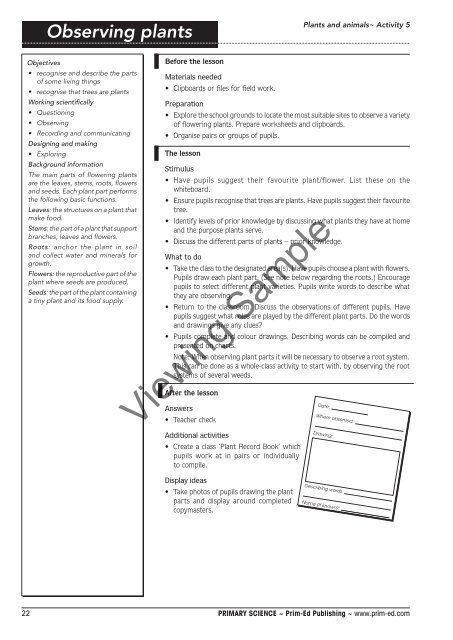PR-0552UK Primary Science - Book 2
Create successful ePaper yourself
Turn your PDF publications into a flip-book with our unique Google optimized e-Paper software.
Observing plants<br />
Plants and animals~ Activity 5<br />
Objectives<br />
• recognise and describe the parts<br />
of some living things<br />
• recognise that trees are plants<br />
Working scientifically<br />
• Questioning<br />
• Observing<br />
• Recording and communicating<br />
Designing and making<br />
• Exploring<br />
Background information<br />
The main parts of flowering plants<br />
are the leaves, stems, roots, flowers<br />
and seeds. Each plant part performs<br />
the following basic functions.<br />
Leaves: the structures on a plant that<br />
make food.<br />
Stems: the part of a plant that support<br />
branches, leaves and flowers.<br />
Roots: anchor the plant in soil<br />
and collect water and minerals for<br />
growth.<br />
Flowers: the reproductive part of the<br />
plant where seeds are produced.<br />
Seeds: the part of the plant containing<br />
a tiny plant and its food supply.<br />
Before the lesson<br />
Materials needed<br />
• Clipboards or files for field work.<br />
Preparation<br />
• Explore the school grounds to locate the most suitable sites to observe a variety<br />
of flowering plants. Prepare worksheets and clipboards.<br />
• Organise pairs or groups of pupils.<br />
The lesson<br />
Stimulus<br />
• Have pupils suggest their favourite plant/flower. List these on the<br />
whiteboard.<br />
• Ensure pupils recognise that trees are plants. Have pupils suggest their favourite<br />
tree.<br />
• Identify levels of prior knowledge by discussing what plants they have at home<br />
and the purpose plants serve.<br />
• Discuss the different parts of plants – prior knowledge.<br />
What to do<br />
• Take the class to the designated area(s). Have pupils choose a plant with flowers.<br />
Pupils draw each plant part. (See note below regarding the roots.) Encourage<br />
pupils to select different plant varieties. Pupils write words to describe what<br />
they are observing.<br />
• Return to the classroom. Discuss the observations of different pupils. Have<br />
pupils suggest what roles are played by the different plant parts. Do the words<br />
and drawings give any clues?<br />
• Pupils complete and colour drawings. Describing words can be compiled and<br />
presented on charts.<br />
Note: When observing plant parts it will be necessary to observe a root system.<br />
This can be done as a whole-class activity to start with, by observing the root<br />
systems of several weeds.<br />
After the lesson<br />
Viewing Sample<br />
Answers<br />
• Teacher check<br />
Additional activities<br />
• Create a class ‘Plant Record <strong>Book</strong>’ which<br />
pupils work at in pairs or individually<br />
to compile.<br />
Display ideas<br />
• Take photos of pupils drawing the plant<br />
parts and display around completed<br />
copymasters.<br />
22 <strong>PR</strong>IMARY SCIENCE ~ Prim-Ed Publishing ~ www.prim-ed.com


















